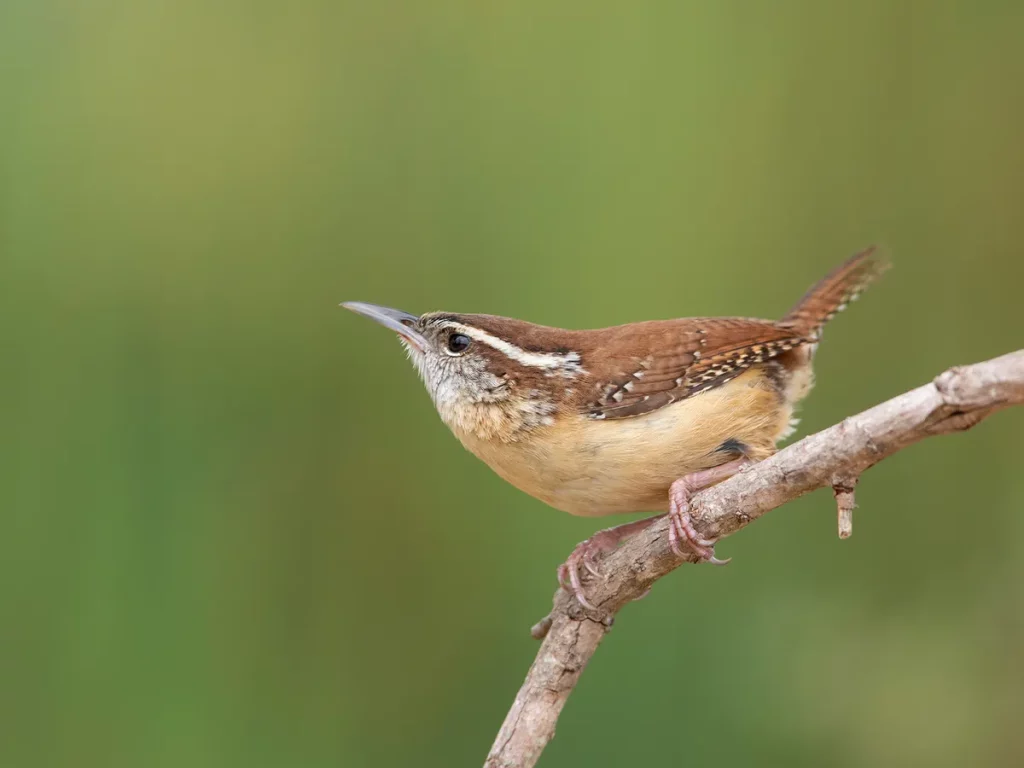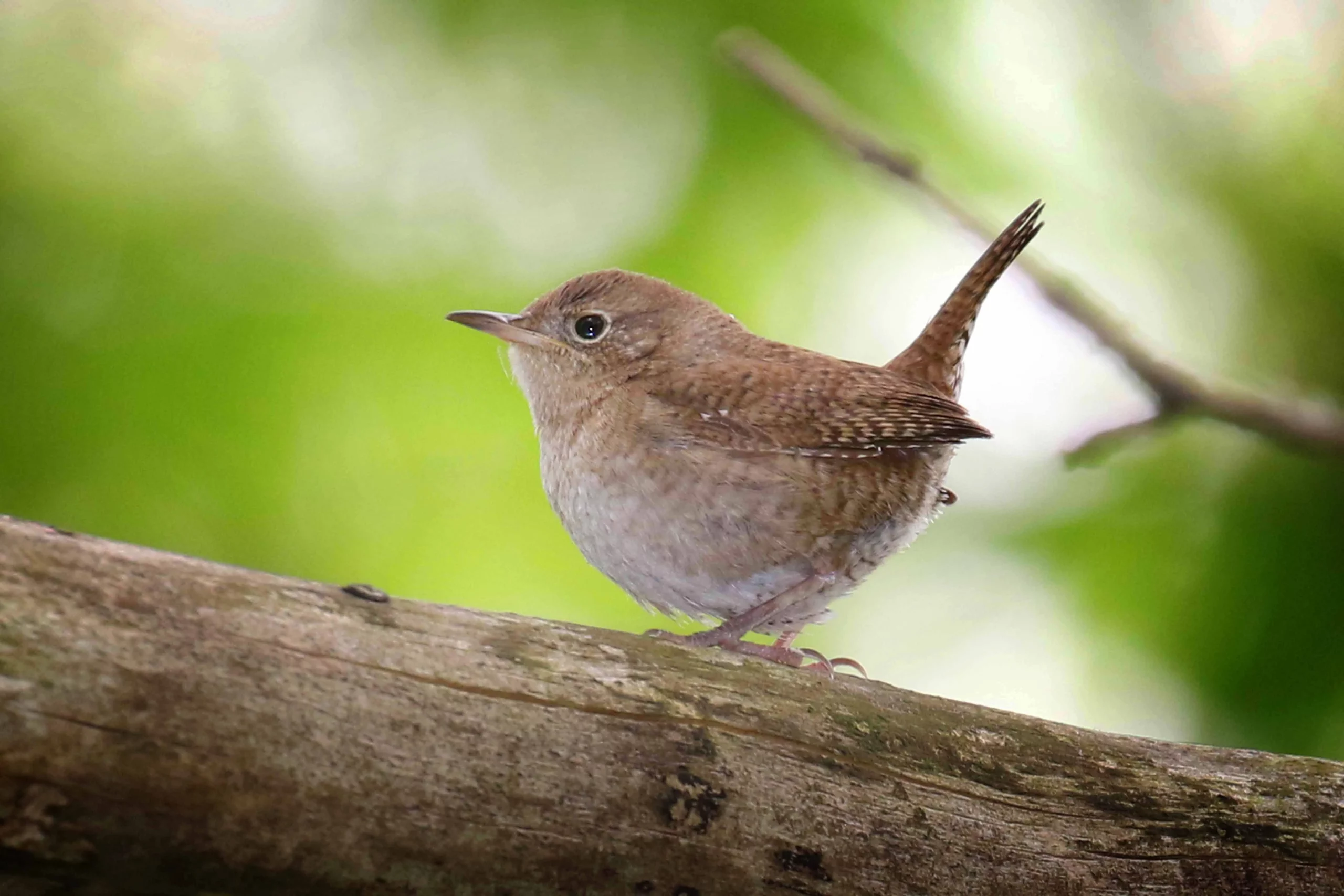In North America, there have been sightings of 11 distinct wren species, with 5 of them discovered in Connecticut. Among these, four wren species are regularly observed, while one is considered accidental.
Connecticut is home to the Carolina Wren throughout the year. During summer, House Wrens and Marsh Wrens can be found in the state, while Winter Wrens are seen during the winter season. Additionally, there are Sedge Wrens to be on the lookout for in Connecticut.
Wrens, although unassuming in appearance, are songbirds with noteworthy personalities. They possess a brown coloration, relatively small size, and plump bodies, along with upright tails and powerful voices.
Wrens primarily inhabit the New World, encompassing North and South America, excluding the Eurasian Wren found in Europe and Africa. They belong to the avian family Troglodyidae.
Insects and spiders form the majority of wrens’ diet, allowing them to thrive in various environments, including arid and rocky areas with limited vegetation.
Initially, the Winter Wren was considered the same species as the Pacific Wren and Eurasian Wren. However, they have now been recognized as three distinct species.
Throughout history, wrens have been intertwined with folklore and symbolism. In Europe, there was a belief that harming wrens would bring about misfortune.
This guide will assist you in identifying the different wren species in Connecticut, based on avibase records. The list ranks the wrens according to their frequency of sightings, ranging from the most to the least observed, as reported by birdwatchers’ checklists submitted to ebird.
To aid in identifying various bird species visiting your backyard, you can obtain a free bird identification photo guide specifically tailored for Connecticut.
Connecticut is home to 5 species of wrens:
1. Carolina Wren

Carolina Wrens are the most commonly spotted wrens in Connecticut and are non-migratory. They appear in 18% of summer checklists and 19% of winter checklists submitted by birdwatchers in the state.
Carolina Wrens exhibit a shy nature and possess dark brown plumage on their upper bodies and light brown undersides. They feature a white eyebrow stripe and an upright tail.
Scientific Name: Thryothorus ludovicianus
Length: 4.7-5.5 in (12-14 cm)
Weight: 0.6-0.8 oz (18-22 g)
Wingspan: 11.4 in (29 cm)
Carolina Wrens reside throughout the year across Eastern and Southeastern States.
These wrens can be found in wooded areas or places with dense vegetation, and they may visit backyard feeders. Their diet primarily consists of insects and spiders, although they occasionally consume lizards, frogs, and snakes.
Carolina Wren sounds: They emit a short song consisting of quick whistles.
Recording by Bobby Wilcox, XC616879. Accessible at www.xeno-canto.org/616879.
Carolina Wrens construct their nests, which are usually located in trees, but they are not selective and may build them in various natural or artificial sites. The nests are typically circular with a small opening on the side. They lay 3-7 eggs, and the incubation period lasts approximately two weeks, followed by an additional two weeks for the chicks to fledge.
To attract Carolina Wrens to your backyard feeders, provide suet feeders, hulled sunflower seeds, or peanut hearts in large tube or platform feeders.
Fun fact: Carolina Wrens mate for life.
2. House Wren

House Wrens appear in 23% of checklists during summer in Connecticut, with the highest occurrence from April to October. While most House Wrens migrate for winter, a few individuals remain in the state throughout the year.
House Wrens are small, unremarkable brown birds with darker wings and tails exhibiting barring, as well as a paler throat. Male and female House Wrens share a similar appearance.
Distinguishing Feature: The eyestripe is less prominent compared to other wren species.
Scientific Name: Troglodytes aedon
Length: 4.3-5.1 in (11-13 cm)
Weight: 0.3-0.4 oz (10-12 g)
Wingspan: 5.9 in (15 cm)
House Wrens breed during summer in the United States and Southern Canada, subsequently migrating to the South and Mexico for winter.
Look for House Wrens in backyards, parks, and open woodlands as they search for insects and spiders. They are often seen energetically hopping through tangled vegetation and low branches, frequently with their tails upright while singing their cheerful songs.
House Wrens primarily feed on insects and spiders such as beetles, caterpillars, and flies. They also consume snail shells as a source of calcium.
House Wren sounds: While not particularly melodic, House Wrens produce a series of jumbled notes that vary in pitch and speed.
Recording by Peter Boesman, XC693927. Accessible at www.xeno-canto.org/693927.
House Wrens build their nests in old woodpecker holes, nest boxes, or other small crevices. They prefer lightly wooded areas and construct their nests using twigs, lining them with softer materials. House Wrens lay 3-10 eggs, with an incubation period of approximately two weeks, followed by another two weeks for the chicks to fledge.
To attract House Wrens to your backyard, create brush piles or put up nest boxes.
Fun fact: Despite their small size, House Wrens display remarkable tenacity. They often engage in aggressive behavior, harassing larger birds to claim optimal nest holes, sometimes even removing eggs or nestlings from desired nesting sites.
3. Marsh Wren

During the breeding season, Marsh Wrens can be observed in Connecticut, appearing in 4% of summer checklists. They are most commonly spotted from mid-April to October, although a few individuals may be present throughout the year.
Marsh Wrens possess brown plumage with black and white streaks on their backs. Their undersides have a grayish-brown hue, and they feature the distinctive upright tail typical of wrens.
Marsh Wrens lack shoulder stripes and have longer bills compared to Sedge Wrens. Both males and females exhibit a similar appearance.
Scientific Name: Cistothorus palustris
Length: 3.9-5.5 in (10-14 cm)
Weight: 0.3-0.5 oz (9-14 g)
Wingspan: 5.9 in (15 cm)
Marsh Wrens breed in the northern U.S. states and Central Canada before migrating to Southern states and Mexico. During migration, some Marsh Wrens can be spotted in the Eastern U.S.
You can find Marsh Wrens in wetland areas, clinging to reeds with each foot grasping a different stalk. They can be challenging to spot, but their singing among the reeds, especially at dawn and dusk, can help locate them.
Marsh Wrens primarily feed on insects and spiders, picking them off leaves near the water.
Marsh Wren sounds: They produce a distinctive buzzy song that can last for up to 20 minutes.
Recording by Jarrod Swackhamer, XC591813. Accessible at www.xeno-canto.org/591813.
Marsh Wrens construct fully enclosed nests, except for a small opening at the top. These nests are woven from reeds and grasses. They lay 3-10 eggs, with an incubation period of around two weeks and a subsequent two-week period for the chicks to fledge.
Fun facts: Marsh Wrens may create up to twenty dummy nests attached to cattails, but they typically utilize only one, destroying eggs and nestlings belonging to rival birds.
4. Winter Wren

While some Winter Wrens can be seen in Connecticut throughout the year, they are more frequently spotted from October to January.
Winter Wrens are small, plump brown birds with darker barring on their wings, tail, and belly. They feature a lighter eyebrow stripe and short tails that are held upright. Male and female Winter Wrens exhibit similar appearances.
Winter Wrens closely resemble Pacific Wrens and were previously considered the same species. However, they are now recognized as distinct species due to their unique songs.
Scientific Name: Troglodytes hiemalis
Length: 3.1-4.7 in (8-12 cm)
Weight: 0.3-0.4 oz (8-12 g)
Wingspan: 4.7-6.3 in (12-16 cm)
Winter Wrens can be found in the eastern U.S. during winter and in northeastern U.S. states and Canada during summer.
Search for Winter Wrens hidden amidst dense undergrowth in forests and backyards. They forage for insects and spiders by rummaging through fallen leaves and decaying bark.
Winter Wren sounds: Their song is long, bubbly, and sweet, slower than Pacific Wrens, lasting up to 10 seconds.
Recording by David Welch, XC575300. Accessible at www.xeno-canto.org/575300.
Winter Wrens construct nests using twigs, moss, and grass, weaving them into a round shape with a small opening. They lay 1-9 eggs, and the incubation period lasts two to two and a half weeks, followed by fledging.
To attract Winter Wrens to your backyard, provide native plants and create areas with dense vegetation.
Fun fact: Winter Wrens build round-shaped nests with small openings, occasionally hanging from trees.
5. Sedge Wren

Considered an accidental species in Connecticut, Sedge Wrens were observed in Fairfield and Windham in 2021.
Sedge Wrens are small brown wrens with darker upper plumage, displaying streaks and barring, and lighter undersides. They possess a small, light eyebrow stripe. Males and females have similar appearances.
Sedge Wrens bear a resemblance to Marsh Wrens and inhabit similar wet areas. However, Marsh Wrens lack striped shoulders and possess lighter bellies.
Scientific Name: Cistothorus stellaris
Length: 3.9-4.7 in (10-12 cm)
Weight: 0.3-0.3 oz (7-10 g)
Wingspan: 4.7-5.5 in (12-14 cm)
Sedge Wrens breed in southern Canada, the Midwest, and sometimes further east in the U.S. They migrate to spend winter in southeastern states and northern Mexico, primarily near the Gulf and Atlantic coasts.
You can find Sedge Wrens concealed within wet grasslands, marshy areas, and meadows with abundant vegetation. They typically prefer shallower areas compared to Marsh Wrens and forage for insects and spiders.
Sedge Wren sounds: Their song consists of a few short notes followed by a series of more rapid notes at a similar pitch.
Recording by Paul Driver, XC659291. Accessible at www.xeno-canto.org/659291.
Fun fact: Sedge Wrens can be aggressive and puncture the eggs of other Sedge Wrens nesting too closely, effectively destroying them.
How to Attract Wrens to Your Backyard
Having wrens visit your backyard allows you to enjoy their beautiful songs and observe their energetic behavior up close. While only a few wren species regularly visit backyards, such as House Wrens, Carolina Wrens, and Berwick Wrens, you can attract them using the following methods:
1. Embrace a less tidy approach: Provide habitats for insects and spiders, which are wrens’ preferred food sources. Leave fallen leaves, brush piles, and spider webs intact.
2. Offer clean water sources: Ideally, have running water available in multiple locations.
3. Provide nesting sites: Wrens may utilize nest boxes or even repurpose old boots left outdoors.
4. Offer suitable food: Wrens will consume mealworms, crickets, peanut pieces, and suet.
How Frequently Wrens are Spotted in Summer and Winter in Connecticut
Checklists serve as valuable resources to determine the most commonly sighted birds. The following lists indicate the frequency of wren sightings in Connecticut during summer and winter, based on ebird checklists:
Wrens in Connecticut during Summer:
– House Wren: 23.9%
– Carolina Wren: 18.3%
– Marsh Wren: 4.5%
– Winter Wren: 1.0%
– Sedge Wren: 0.1%
Wrens in Connecticut during Winter:
– Carolina Wren: 19.4%
– Winter Wren: 1.4%
– Marsh Wren: 0.2%
– House Wren: <0.1%
